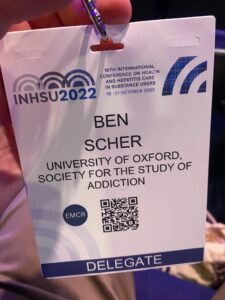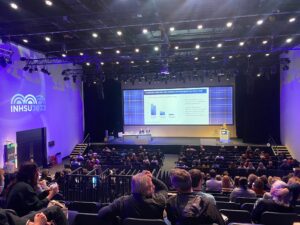In Early November Ben Scher joined an international group of policymakers, practitioners, community organisers, people with lived/living experience and academics at the 10th International Conference on Health and Hepatitis Care in Substance Users (INHSU) in Glasgow.
Peer research

My first day started with a workshop on peer research run by Dr Matt Smith from Glasgow Caledonian University. With academic disciplines taking more and more of an interest in community-engaged research, Dr Smith asked the questions: ‘What does ethical, equitable, peer-led research mean in the context of drug policy and drug service evaluation?’, ‘Where does the power lie within these contexts?’, ‘Are university systems set-up for meaningful peer research?’ and ‘Do the expectations of funders and ethics committees reflect the logistical realities of conducting peer research?’
Breaking into small groups to discuss these questions, people with lived and living experience and researchers agreed that the quality and validity of research and the potential for broader policy impacts is improved through deeper engagement with people who use drugs. From my experience in research thus far, I wholeheartedly believe this to be true.
From research design, all the way through data collection, analysis and dissemination, workshop participants spoke of the characteristics of successful projects as well as what happened in those that fell short due to a lack of meaningful engagement. For my own PhD project, it was valuable to hear a variety of perspectives on how peer research should be conducted in ethical, equitable and effective ways.
Overdose prevention sites
The second session I attended featured Ann Livingston. I grew up in Vancouver and over the years having worked in a few different Vancouver-based OPCs, Ann was often discussed as a legendary figure in Vancouver’s harm reduction movement. Ann is a founding member of the Vancouver Area Network of Drug User (VANDU) and was instrumental in establishing INSITE, North America’s first overdose prevention centre (OPCs).
It was my first time hearing Ann speak and it was inspiring to hear how in the face of Vancouver’s HIV epidemic and then later the overdose crisis, community groups and civil society came together to not just demand change but bring about change, breaking the law and providing unsanctioned overdose prevention centres despite government pushback.
“Protest is like begging the powers that be to dig a well. Direct action is digging the well and daring them to stop you.”
By defying the law and providing evidence-based harm reduction in the face of preventable deaths, Ann and VANDU laid a blueprint for bottom-up policy reform. Her message resonated with me, especially in the UK context where OPCs struggle to gain political backing, despite the evidence of their effectiveness and the rising number of preventable drug-related deaths.
As Peter Krykant demonstrated, OPCs are viable and effective in the UK and based on Ann’s presentation, the question really is would the government halt the provision of life saving services, or, is direct action the only way for meaningful drug policy reform?
Key takeaways
- Meaningful peer-led research can increase the accuracy of research findings and works to address power imbalances with research processes.
- Drug user mobilization is often necessary to propagate drug policy reform.
- Emerging evidence on safer supply in Canada highlights the array of benefits.
- People who use drugs need to be at the centre of drug service design and delivery in order to increase access and positive outcomes for participants.
Safer supply
Next, I heard from three people pioneering the safer supply movement in Canada: Dr Marie-Eve Goyer from the CIUSSS Centre-Sud-de-l’Ile-de-Montreal, Canada and Matt Bonn and Alexandra Holtom from the Canadian Association of People Who Use Drugs. Although the practice of offering people a safe, regulated supply was invented by Dr. John Marks in Liverpool in the 80s (and to great success), it has become somewhat forgotten in the UK (except for Danny Ahmed’s trial in Middlesbrough, which despite demonstrated positive impact has recently lost its funding). Taking us through the established evidence base from Switzerland, the Netherlands and Germany as well as the emerging evidence from Canada, all three presenters touched on the individual health and wider social benefits of safe supply programs.
“Safer supply enables life.”
I listened on with interest as each presenter described in detail how in their service safe supply was changing people’s lives for the better. Firstly, in light of the growing number of overdose deaths in North America, the provision of pharmaceutical grade drugs greatly decreases the chance of overdose caused by fentanyl adulterated opioids, reducing both mortality rates and rates of hospitalization.
What if instead of talking about hard-to-reach patients, we flip that and talk about hard-to-reach doctors? or hard to reach services?
As I watched their presentations, I couldn’t help but wonder what more it would take to upscale this intervention. It was clearly reducing death within a context of unprecedented overdose deaths. Beyond this primary public health objective, safer supply programs were also removing the need for people to spend time seeking out illicit substances on the black market, giving people back the time to engage in activities which provide stability and well-being such as spending time with friends and family, employment or education.
Just like the results shown from OPCs, day in, day out, these safer supply programs are connecting more marginalised community members with housing, advocacy, medical and legal services. The most recent data we have from the Middlesborough pilot demonstrates a 60% drop in criminal activity and significant improvements in the rates of mental, physical and psychosocial health of participants. These positive results speak to the utility of this intervention in the UK.

Spanish harm reduction programmes
The fourth talk that really stood out to me was by Aura Roig Forteza from Metzineres in Barcelona. Returning from a stint working at INSITE in Vancouver, in 2017 Aura founded Metzineres, Spain’s first harm reduction program exclusively for women and gender non-conforming people. The service offers a supervised consumption space, showers, beds, meals, activity programs, health care and clothing to womxn living in situations of vulnerability.
“Metzineres is an innovative harm reduction model, based on intersectional feminism and peer support, with a comprehensive and holistic approach.”
With both a holistic and individualized framework of care, Metzineres emphasizes the uniqueness of each womxn and each situation. Access to services is immediate, with no formal intake process. Instead, staff and peers build up trust over time and information regarding each participant is digitally systematized over an extended period, following informal conversations. The Metzineres model also provides multiple avenues for peer employment and engagement within service delivery.
“The Metzineres model aims to be one that provides consistency, is reliable, pragmatic, cost effective and one in which each womxn plays a central role. Rather than creating an exhaustive and exclusive list of entry criteria, emphasis is placed on reaching those facing multiple, simultaneous and interconnected social vulnerabilities.”
Hearing how peers are at the forefront of Metzineres services made me reflect on the formal, often medicalised forms of service delivery present within UK drug services. Each context differs and what works in Barcelona might not necessarily work in the UK. Regardless, I really think the question needs to be asked: how can we provide ethical, effective and welcoming services that people experiencing intersecting vulnerabilities want to engage with? This sentiment was perfectly expressed by Dr. Angela Sereda from the Intercommunity Health Centre in London, Ontario:
“What if instead of talking about hard-to-reach patients, we flip that and talk about hard-to-reach doctors? or hard to reach services?”
In Aura’s presentation, terms such as “radical tenderness” and “activism of care” stood out as compelling lenses through which to develop and evaluate drug services. Her approach and the work being carried out by the wxman (they use this word to signify cis women, trans women and gender diverse people) of Metzineres made me stop and consider the ethos of service provision in the UK.
Attending the INSHU conference opened my eyes to innovative approaches both to research but also drug service provision. In relation to my own PhD research, it pushed me to think of ways in which I could conduct my own research as ethically and rigorously as possible. More broadly, it also made me question what truly are flexible, low-barrier services? This is something I believe service providers here in the UK also need to reconsider.
by Ben Scher
The opinions expressed in this post reflect the views of the author and do not necessarily represent the opinions or official positions of the SSA or the author’s academic institution.
The SSA does not endorse or guarantee the accuracy of the information in external sources or links and accepts no responsibility or liability for any consequences arising from the use of such information.

